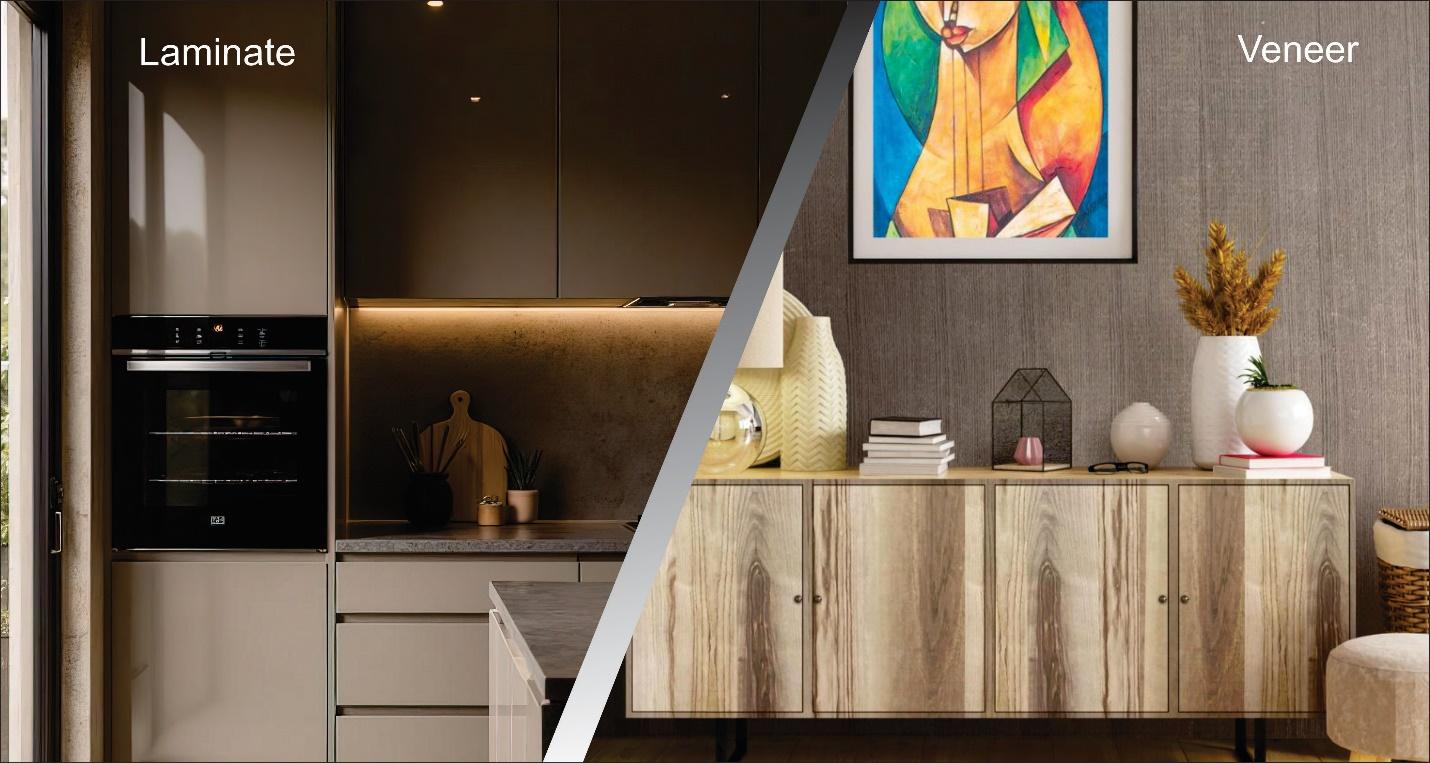Glossy Laminates: Complete Guide to Benefits, Uses & Designs
The charm of a beautiful home often lies in the subtle details, from the textures and colours to the finishes that define its personality. Among these, glossy laminates have become

When it comes to choosing surface finishes for furniture and interiors, laminates and veneers are two of the most widely used options. Both offer unique benefits in terms of appearance, durability, and cost, which often leads to confusion among homeowners and designers alike. The difference between laminates and veneers isn’t always clear at first glance, especially since both can mimic natural textures and finishes. However, understanding their key distinctions is essential for making an informed choice.
In this blog, we break down the pros, cons, and best use cases to help you confidently decide between laminates vs veneers for your space.
Laminates are multi-layered synthetic materials used as surface finishes in furniture and interior design. They are made by pressing layers of kraft paper, decorative paper, and a protective overlay together using heat and pressure. The result is a durable, versatile sheet that is applied to substrates like plywood or MDF.
There are two main types: High-Pressure Laminates (HPL), which are more durable and moisture-resistant, and Low-Pressure Laminates (LPL), which are more affordable but less robust.
Laminates are commonly used for kitchen cabinets, wardrobes, countertops, wall panels, and even flooring, thanks to their wide variety of colours, textures, and finishes.
Read about – A Complete Guide to Laminates for Interior Design.
Veneers are thin slices of natural wood that are bonded to a base material like plywood, MDF, or particleboard. Unlike laminates, veneers are made by slicing logs into fine sheets, which retain the authentic grain, colour, and texture of the original wood.
Veneers are widely used in luxury furniture, premium cabinetry, wall panels, and interior detailing where a rich, organic look is desired. They can be stained, polished, or lacquered to suit various design styles—from traditional to modern.
Understanding the difference between laminates and veneers helps in making informed choices for your interiors.
| Parameter | Laminates | Veneers |
| Material Base | Made from synthetic layers of paper and resin | Made from thin slices of real natural wood |
| Cost | Generally more affordable | Typically more expensive |
| Appearance | Offers uniform designs and colours | Showcases natural wood grains and variations |
| Durability | Highly resistant to scratches and wear | Can scratch or dent more easily |
| Maintenance | Low maintenance and easy to clean | Needs regular care like polishing or sealing |
| Water Resistance | Good water resistance, especially in HPL | Moderate resistance; needs protective coating |
| Eco-friendliness | Synthetic and less biodegradable | More sustainable if sourced responsibly |
| Application Suitability | Ideal for functional, high-use areas like kitchens and wardrobes | Best for luxury furniture and decorative panels |
Explore the expert guide about – Tips for Selecting Perfect Laminate Sheets.
Choosing Between Laminates Vs Veneers Depends on Your Priorities:
Quick Checklist:
✔ Budget-friendly: Laminates
✔ Luxury, natural look: Veneers
✔ High-use spaces: Laminates
✔ Premium design: Veneers
Know more about – The Right Choice For Your Home Decor.
The use of laminates and veneers in interior design often involves striking a balance between style and practicality. In one project, a homeowner chose laminates for the kitchen cabinets and wardrobes due to their affordability, durability, and resistance to moisture, making them ideal for high-traffic areas. Meanwhile, an interior designer used veneers for the luxury apartment’s living room panelling and dining table to create a warm, high-end feel with a natural wood grain.
In many modern homes, laminates and veneers in interior design are combined—laminates for everyday furniture and storage, and veneers for statement pieces, ensuring both performance and elegance in the overall look.
Know more about – How Decorative Laminates Can Transform Your Home Interiors?
Understanding the difference between laminates and veneers is crucial when selecting finishes for your interior spaces. While laminates offer durability, easy maintenance, and affordability, veneers provide unmatched natural beauty and a luxurious feel.
The best choice between laminates vs veneers depends on your space, budget, and personal style preferences. For expert guidance and premium surface solutions, consult with design professionals at Ventura International, where you can explore a wide range of high-quality laminates and veneers tailored to your interior needs.
It depends on your needs—Ventura Architectural laminates are better for durability and budget; Nature Signature veneers are ideal for natural aesthetics.
Ventura Architectural laminates are more durable, especially in high-use and moisture-prone areas.
Most furniture uses laminate for cost-effectiveness and durability.
Yes, veneers require more care, including polishing and protection from moisture and scratches.
Veneers are typically more expensive due to the use of real wood.